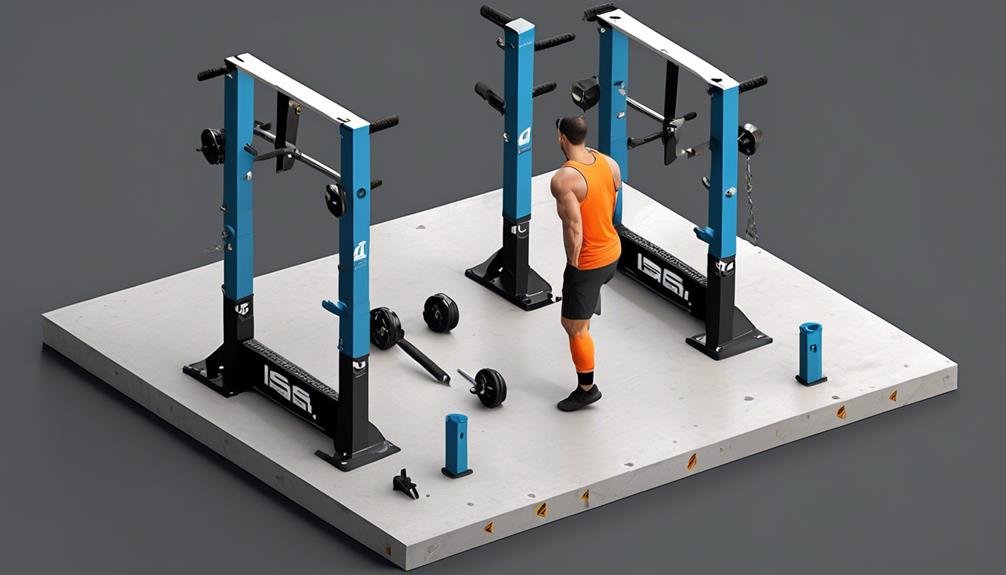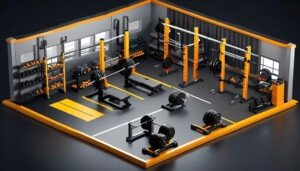Have you ever been in a gym and noticed a squat rack wobbling precariously as someone tries to lift heavy weights? It's a situation that not only compromises safety but also creates a distraction for others.
Properly anchoring equipment like squat racks is crucial to prevent tipping and ensure a stable workout environment. But how exactly can you achieve this? In this discussion, we will explore the importance of proper equipment anchoring, guide you through the process of anchoring a squat rack, highlight common mistakes to avoid, and provide additional tips and considerations for maximizing safety and stability.
So, let's dive in and discover how you can ensure a solid foundation for your workout routine.
Key Takeaways
- Properly anchoring equipment is crucial to prevent tipping and ensure safety and stability.
- The type and weight of the equipment, as well as the type of flooring, should be considered when choosing the appropriate anchoring method.
- Following the manufacturer's recommendations and instructions for anchoring is essential for maintaining equipment stability.
- Regular inspection and maintenance of the anchoring system, as well as ensuring proper alignment and balance, are important for long-term safety.
Importance of Proper Equipment Anchoring
Properly anchoring equipment is of utmost importance to prevent tipping and ensure the safety and stability of the equipment. When it comes to heavy and bulky equipment like squat racks, proper anchoring becomes even more crucial.
Squat racks are designed to support heavy weights and provide stability during exercises like squats and bench presses. However, without proper anchoring, these racks can become unstable and prone to tipping, leading to serious injuries.
To understand the importance of proper equipment anchoring, let's consider the forces at play. When you load weight plates onto the rack, the center of gravity shifts, creating a potential tipping point. Additionally, the dynamic forces generated during exercises can cause the rack to sway or wobble. Without proper anchoring, these forces can easily overcome the stability of the rack, increasing the risk of accidents.
Proper anchoring involves securing the squat rack to the floor using anchor bolts or other suitable methods. Anchor bolts should be chosen based on the type of flooring material and should be installed at the recommended spacing and depth. It's also essential to regularly inspect and maintain the anchor bolts to ensure their integrity and effectiveness.
Choosing the Right Anchoring Method
To ensure the stability and safety of your equipment, it's crucial to carefully select the appropriate anchoring method. Choosing the right anchoring method is essential in preventing equipment tipping and potential accidents. There are several factors to consider when deciding which method to use.
Firstly, evaluate the type of equipment you have and its weight. Different anchoring methods are suitable for different types of equipment. For example, wall-mounted brackets are ideal for lighter equipment, while floor-mounted anchors are better suited for heavier pieces.
Secondly, assess the type of flooring in your facility. Concrete floors provide a strong foundation for anchoring, while wooden or tiled floors may require additional reinforcement. Consider using floor anchors that can be secured to the concrete subfloor to ensure stability.
Thirdly, consider the space available in your facility. Wall-mounted anchors can be a space-saving option, especially in smaller areas. Floor-mounted anchors may require more space but offer greater stability.
Lastly, consult the manufacturer's recommendations for your specific equipment. They'll often provide guidance on the most suitable anchoring method to ensure proper stability and safety.
Step-by-Step Guide to Anchoring a Squat Rack

To ensure the stability and safety of your squat rack, follow this step-by-step guide for properly anchoring the equipment.
- Determine the type of anchor suitable for your flooring:
- If you have concrete flooring, use concrete wedge anchors. These provide a secure and stable foundation.
- For wooden or tiled floors, use lag bolts or expansion anchors. These options allow for easy installation and provide adequate stability.
- Position the squat rack and mark the anchor points:
- Use a measuring tape to determine the correct distance between the anchor points. This ensures proper alignment and balance.
- Mark the anchor points on the floor using a marker or chalk. Double-check the measurements to avoid any errors.
- Drill holes and install the anchors:
- Use a suitable drill bit to create pilot holes at the marked anchor points.
- Insert the anchors into the pilot holes and tighten them using a wrench or socket set.
- Ensure the anchors are securely fastened and flush with the floor.
Common Mistakes to Avoid During Equipment Anchoring
One common mistake to avoid when anchoring equipment is neglecting to properly assess the stability of the chosen anchor points. Anchoring equipment is essential to prevent tipping and ensure the safety of users. However, if you fail to evaluate the stability of the anchor points, you risk compromising the effectiveness of the anchoring system and potentially endangering yourself or others.
Firstly, it's crucial to choose anchor points that are strong and secure. Weak or unstable anchor points can lead to equipment movement or even detachment, which can result in accidents or injuries. Therefore, it's necessary to inspect the anchor points carefully before proceeding with the anchoring process.
Another common mistake is using inadequate anchoring materials. Using subpar or inappropriate materials can compromise the stability of the equipment, making it susceptible to tipping. It's crucial to use high-quality, durable materials that are specifically designed for anchoring purposes. This will ensure the equipment remains securely in place and effectively prevents tipping.
Lastly, failing to follow manufacturer instructions is a common mistake to avoid. Manufacturers provide specific guidelines for anchoring their equipment, taking into account factors such as weight, size, and intended use. Ignoring these instructions can lead to improper anchoring, increasing the risk of tipping. Always refer to the manufacturer's recommendations and follow their instructions precisely.
Ensuring Safety and Stability: Additional Tips and Considerations

For optimal safety and stability when anchoring equipment, it's important to consider additional tips and factors that can further enhance the effectiveness of the anchoring system. These tips and considerations will help ensure that your equipment remains secure and prevents any potential tipping hazards:
- Choose the right anchoring method: Depending on the type of equipment and the surface it will be anchored to, different methods may be required. Common options include using concrete anchors, floor mounting plates, or wall brackets. Carefully assess the equipment and its surroundings to determine the most appropriate anchoring method.
- Follow manufacturer guidelines: Always refer to the manufacturer's instructions for proper anchoring procedures. They'll provide specific recommendations and guidelines for your equipment, taking into account its design, weight, and intended use. Following these instructions will help ensure that the equipment is properly secured.
- Regularly inspect and maintain the anchoring system: Over time, the anchoring system may experience wear and tear. Inspect the anchor points, fasteners, and connections regularly to ensure they remain in good condition. If any damage or deterioration is detected, address it promptly to maintain the stability and safety of the equipment.
Frequently Asked Questions
Are There Any Alternative Methods of Anchoring Equipment Besides the Ones Mentioned in the Article?
There are alternative methods of anchoring equipment besides the ones mentioned in the article. These methods provide additional stability and prevent tipping. Some options include using wall mounts, floor anchors, or weight plate storage racks.
How Often Should I Check the Stability of My Anchored Equipment?
To ensure the stability of your anchored equipment, regularly check for any signs of movement or loosening. By inspecting the anchoring components and verifying their tightness, you can maintain a safe workout environment.
Can I Use the Same Anchoring Method for All Types of Squat Racks?
To properly anchor equipment like squat racks and avoid tipping, you should use the appropriate anchoring method for each type of rack. Different racks may require different methods to ensure stability and safety during use.
What Are the Potential Consequences of Not Properly Anchoring a Squat Rack?
Not properly anchoring a squat rack can lead to serious consequences. The rack may tip over during use, causing injury or damage to surrounding equipment. It is crucial to follow proper anchoring procedures for safety.
Are There Any Specific Weight or Load Limits That I Should Be Aware of When Anchoring Equipment?
When anchoring equipment like squat racks, it is important to consider weight and load limits. Exceeding these limits can lead to instability and tipping. Always adhere to manufacturer guidelines for proper anchoring to ensure safety.
Conclusion
In conclusion, properly anchoring equipment like squat racks is crucial for ensuring safety and stability during workouts. By following the step-by-step guide and avoiding common mistakes, individuals can effectively anchor their equipment and prevent tipping accidents.
Choosing the right anchoring method and considering additional tips and considerations will further enhance the overall stability of the squat rack. Taking these measures will provide a secure environment for users and minimize the risk of injury.





